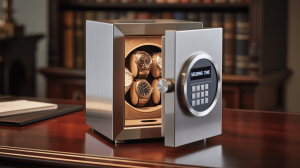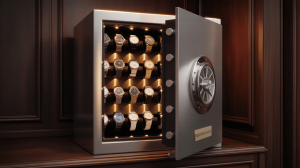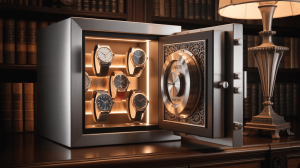Choosing the Right Safe for Watches: Tips and Tricks. But here’s the kicker… Selecting the perfect safe means balancing security, climate control, and display convenience to keep your timepieces pristine and accessible.
1. Evaluate Security Ratings
Start by checking burglary certifications such as UL RSC or ETL. Reinforced steel walls, heavy bolts, and anti‑pry doors provide robust defense. Assess local crime risk to decide if you need higher ratings.
| Rating Standard | Protection Type | Typical Duration/Resistance |
|---|---|---|
| UL RSC | Burglary resistance | Up to 5 min attack time |
| ETL Security Spec | Break‑in deterrence | Comparable to UL RSC |
2. Determine Fire and Heat Resistance
Look for UL 72 Class 350 fire ratings offering 30–60 minutes at 1,200–1,400 °F. Intumescent gaskets seal out smoke and heat, keeping internal temps under 350 °F to protect lubricants and materials.
3. Measure Available Space
Measure your intended spot—nightstand, closet shelf, or wall niche. Include depth for hinges and handle clearance. Plan capacity: allow ~2 inches width and 1.5 inches height per watch on pillows, plus room for backups and tools.
4. Select Durable Materials
The exterior gauge and interior lining matter. 12–14 gauge steel resists tampering. Fireboard or gypsum panels provide insulation. Interiors use high‑density foam or velvet to prevent scratches.
| Material Component | Role | Benefit |
|---|---|---|
| Steel Shell | Structural security | Resists drilling |
| Fireboard Panels | Heat insulation | Maintains low internal temps |
| Foam/Velvet Lining | Watch cushioning | Prevents dings |
5. Choose Lock Type
Electronic keypads offer multiple user codes and time delays. Biometric scanners provide one‑touch access but need backup keys. Mechanical locks never fail due to power loss but require key storage.
6. Plan Interior Organization
Modular trays and removable watch pillows help customize layout. Consider winder modules if you own automatics; otherwise, foam inserts and strap slots keep everything tidy and accessible.
7. Consider Watch Winder Integration
If automatic watches are in your collection, choose safes with programmable winders. Look for adjustable turns‑per‑day (TPD), rotation direction control, and silent motors under 25 dB to avoid noise intrusion.
| Winder Feature | Specification | Collector Advantage |
|---|---|---|
| Adjustable TPD | 650–1,800 turns/day | Matches watch manufacturer specs |
| Rotation Direction | CW, CCW, bi‑directional | Prevents overwinding |
| Noise Level | < 25 dB | Quiet bedroom/office use |
8. Ensure Climate Control
Humidity and dust can damage movements and straps. Seek IP54‑rated seals and built‑in desiccant chambers or digital hygrometers. Active dehumidifier modules in higher‑end models maintain optimal 40–50% RH.
9. Evaluate Accessibility
Quick access matters. Electronic or biometric locks grant fast entry, while mechanical overrides ensure no lockouts. Interior LED lighting enhances visibility, letting you select watches easily.
10. Explore Smart Features
Modern safes offer Bluetooth or Wi‑Fi connectivity. Receive tamper and door‑open alerts, monitor battery levels, and adjust winder settings via smartphone apps for real‑time peace of mind.
| Smart Capability | Functionality | Benefit |
|---|---|---|
| Tamper Alerts | Immediate notifications | Quick security response |
| Remote Control | Lock/unlock via app | Convenience |
| Audit Logs | Access history tracking | Usage accountability |
11. Assess Power and Backup
Electronic safes run on AA batteries or rechargeable packs. Look for low‑battery warnings to avoid unexpected shutdowns. A manual key or mechanical dial override provides critical emergency access.
12. Incorporate Aesthetic Style
Safes no longer need to look industrial. Choose finishes—matte black, wood veneer, leather wrap—that complement décor. Interiors with carbon‑fiber accents or wood panels elevate presentation.
| Finish Option | Visual Appeal | Integration |
|---|---|---|
| Matte Black | Sleek modern look | Versatile in most settings |
| Wood Veneer | Warm luxury | Matches furniture |
| Leather Wrapped | Rich texture | Blends in luxury interiors |
13. Plan Installation and Anchoring
Even the best safe fails if removable. Use supplied anchor kits or heavy‑duty bolts into studs or concrete floors. Conceal mounting points under lining to maintain a clean look.
14. Balance Budget vs. Value
Entry‑level safes ($150–$300) cover basic security and foam interiors. Mid‑range ($300–$700) adds fire rating, climate control, and keypads. Premium models ($700+) include biometric access, smart features, and luxe finishes.
| Price Range | Key Features | Ideal Buyer |
|---|---|---|
| $150–$300 | Steel shell, basic lock | Beginner collectors |
| $300–$700 | Fire rating, keypad, Hygro | Enthusiasts |
| $700+ | Biometric, smart integration | High‑end collectors |
15. Final Selection Checklist
Compile your priorities: security rating, fire resistance, capacity, lock type, climate control, aesthetics, and smart features. Compare certified models side‑by‑side to find the perfect blend for your lifestyle and collection.
Conclusion
Choosing the right safe for watches ensures protection against theft, fire, and environmental risks while complementing your décor. Ready for the good part? Use these tips and tricks to secure your timepieces in style and enjoy lasting peace of mind.
FAQ
Q1: What burglary rating do I need?
Aim for UL RSC or ETL for residential security.
Q2: Is fire protection necessary for small collections?
Yes—fire can destroy watches quickly; even 30 minutes rating helps.
Q3: Do smart features add security?
They enhance monitoring but don’t replace core certifications.
Q4: How often replace desiccant packs?
Every 6–12 months to maintain optimal humidity.
Q5: Can I install a safe myself?
Yes—DIY anchoring is possible; ensure proper hardware into solid structures.







